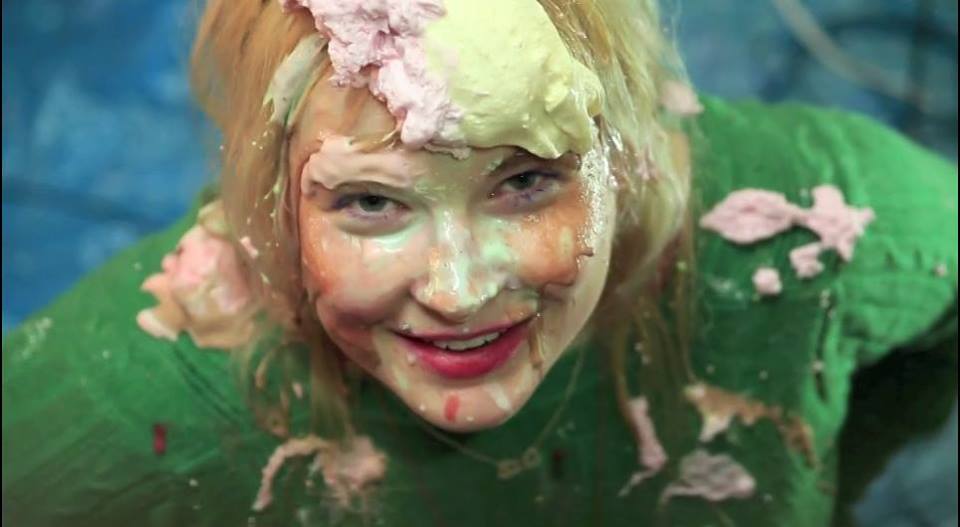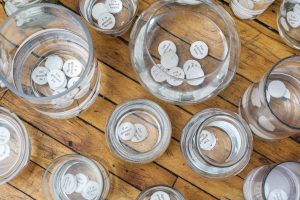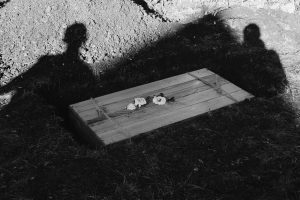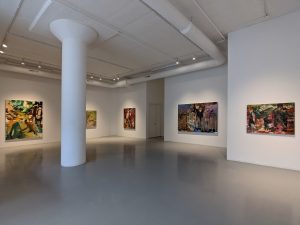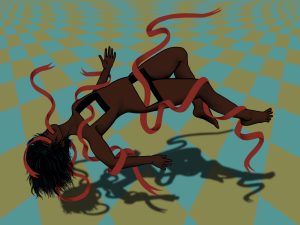“Intimate Justice” looks at the intersection of art and sex and how these actions intertwine to serve as a form of resistance, activism, and dialogue in the Chicago community. For the first installment, we visited visual artist Claire Arctander in her home studio to discuss her video, sculptural, and performance-based practice.
S. Nicole Lane: Let’s begin with the general background questions. Where did you go to school? How did you begin working with film and performance?
Claire Arctander: I am pretty much a Chicagoan through and through. I grew up in a suburb. My parents were artists when I was growing up, and my dad is still an artist. He teaches art at McHenry County College, so I was exposed to art. It’s just a typical practice and a way to express oneself. Then I went to undergrad at Northwestern. I always really loved writing, so that’s the direction that I thought I was going to go in. Writing is still important to me, but as soon as I started school there I pretty quickly veered towards visual art more than I expected to. I studied Art and Gender Studies. After a break of several years, I went to grad school at UIC at the MFA Studio Arts Program there. I finished that in 2011. I’ve done adjunct teaching for about five years. Now I’m a teaching artist at the MCA and I do PR, writing, and I’m going to be starting some education programming at the Weinberg/Newton Gallery.
Art has always been a part of my life. As far as my own art practice goes, I have a multifaceted way of working. I definitely have a video practice, which you’re familiar with, I make objects, and I also tend to do large-scale collaborative works. Example of this are larger installations, a series of events, site-specific works, most significantly with my good friend Latham Zearfoss, but I’ve worked with other people as well. I also consider the educational bit of what I do to be a part of my practice too.
As far as the currents that continue to flow underneath the work that I do over time, it’s a lot about embodied experience, particularly in some sort of female register. I’m looking at that in lots of different ways. Desire, and the slipperiness of that. Desire and revulsion are really tied together. I think that relates to a lot of the sexual experience. I tend to explore that if it’s through making objects, sculptures, or drawings, definitely in my video work which has typically been pretty performative. My video performances are slightly more produced than a straight up documentation of a performance video. My most recent video work was a short experimental narrative that I completed last year.
SNL: What caused that shift from documenting performances to a more narrative film angle? Do you see yourself moving in that direction more?
CA: Yeah, I think I was seeing narrative tendencies. I kept collecting ideas and coming up with this character of the fledgling, who is this searching female magician that is looking for role models for inspiration. She’s having a hard time finding them in the precedents that have been set in the field, which is a metaphor for other things like the field of art. It just felt like the right time. I really liked working that way. I do want to do more of it in the future.
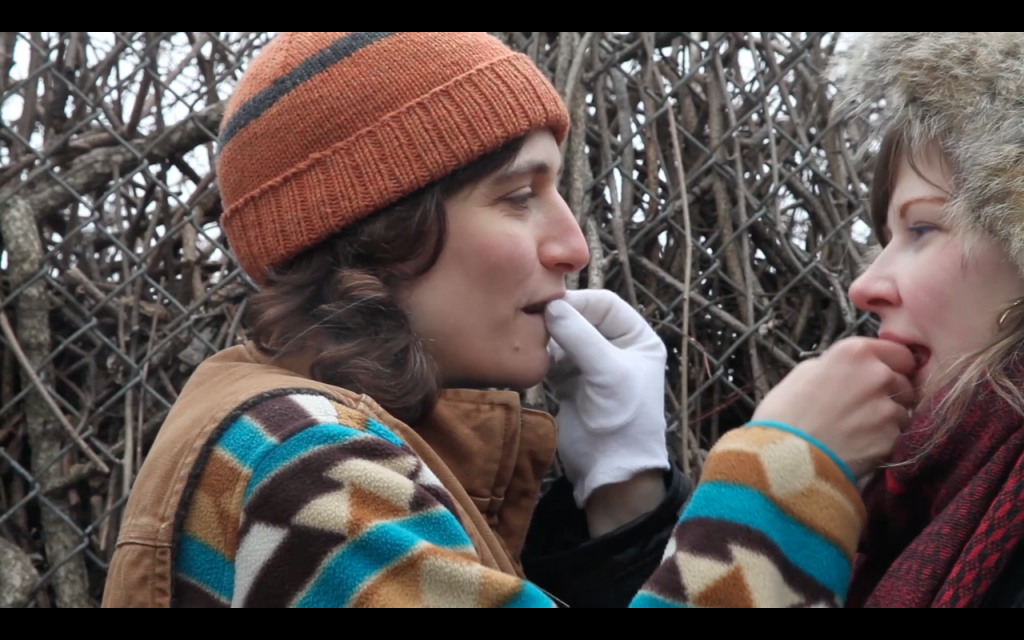
This past year or so, I have been more focused on doing latch hook work. I started doing latch hook work a couple of years ago and using it more as a sculptural material. They don’t explicitly deal with sexuality like the videos, but I still see them as something containing this wild mess of desire or offering something that is this aestheticized representation of some sort of perversion. They still have that energy, even though it’s not as clear. The magician movie is not as straight forward, but there is imagery of fountains and running water. You only see women throughout the whole film. It is thinking about the embodied experience of a woman and how we can inspire one another. There is a make out scene at the end of the film between me and my partner. The magic is happening there, too.
SNL: I feel like much of your work has a lot of connectivity. For example, in the make out scene, you each pull something out of one another’s mouths, and then in Feeding Time, bondage is present, and in a performance that I was a part of at Heaven Gallery, you had us all tie our shoelaces together.
CA: Oh, you were one of the volunteers?!
SNL: Yeah!
CA: Oh my god! That’s so cool! I haven’t thought about it in my work exactly like this way before. I do think that it makes sense in terms of trying to draw out very simple, obvious, everyday ways of how people are connected. It’s not something that’s always spoken about. I’m trying to push that. With the performance at Heaven Gallery, it’s something that’s meant to bring everyone together by tying their shoes together in a circle. I wanted to play the guru role in that moment but also cause mischief. It was a forced togetherness so there was some tension there. Everyone was a good sport and laughing. You all had to figure out how to get out of the situation, and get down on the ground, and untie your shoelaces.
There are heavier subtexts to the work that I do. I think about dynamics of control and power in our culture, especially as they relate to sex. I look at the ways that people react to one another, and in ways that are gender coded in our world. But, I always want there to be a playfulness to it.
The Feeding Time video is a short and sexy burst. There isn’t a huge sense of levity in the way that I’m performing in the video, as I’m chewing the licorice off of the person’s wrists. And the fact that he doesn’t move away once I’m done chewing it all off. He’s free, but he’s just staying there in that position. I want there to be a nod that’s like, “Okay, this is consensual.” I’m playing with power dynamics, but this person was really into it because they didn’t pull away when they could.
I also have a photograph called Easy Bondage that is a photo of my wrists held in that position with an easy squeeze cheese product tying them together. That was an earlier piece. Feeding Time was a more expanded iteration of that idea.
Power dynamics are very real, but I’m also fucking with the expected direction. It’s not always clear who’s in control or not. That is really important to me. Women who are stereotypically expected to be in more subjugated roles are seen as very femme, more quiet, and have a more girly effect. These things are often coded in our culture as not as powerful. I want to mess with that because I don’t think that it’s necessarily true at all. I want to complicate those dynamics through simple gestures.
SNL: Especially in Feeding Time the composition looks similar to an old-school porn.
CA: I definitely think about the staging of those shots. It’s so close up, and it definitely has that reference of that close up porn shot. Also in my video The Right to Piss in Different Colors, I was thinking of POV porn with the framing of that shot. That was the inspiration for how that was framed. That’s probably my favorite thing that I’ve ever made. It’s the one where there are a bunch of different colors of ice cream being thrown at my face. The scene goes on for a while. We did it in one take, one shot. I had never done it before. I had two friends help me and they were behind the camera and also flinging the ice cream. I like working that way with a performance video. I’ve definitely had times where I was like, “Well, that didn’t work” and it wasn’t going to be the same if I did it again so I have to scrap it. In this case, I think it worked really well. It manages in this really simple way. There is an emotional arc in the video. When I screen it, people will laugh initially, and then they hit a point when they feel uncomfortable. Then people feel horrified for me, and then there are some people who are still laughing at me. People’s responses are pretty telling. There does become a point in the video when my face is so covered in ice cream and goop and it gets pretty gnarly.
SNL: Yeah, I had that reaction to Everything She Wants. That’s the piece where you were pouring various forms of liquid into your mouth. Once it started getting to Nyquil and the Elmer’s Glue, the revulsion was consuming. I was worried for you. There were all of these ranges of emotions. It created an intimate moment.
CA: Hopefully! I like that. I hope to create empathic moments with audience members. Especially with audience members who don’t readily identify with me or look like me. I love when women audience members identify with me, but I want to sort of force the dudes to identify with a woman in this given situation as well. When I feel like that’s happening, it’s really awesome. Even if it happens for a moment. Especially in our culture today, it’s important to keep trying to push the bounds of identification and empathy through artwork. So yeah, it’s great that you felt that way.
SNL: Yeah, I love that piece.
CA: That was the first video work I had ever made. It got my wheels turning to think about all of these other video performance pieces that I could do.
SNL: It reminds me of Cheryl Donegan’s piece, Head.
CA: Cheryl Donegan! I was trying to refer to her. I love that piece so much. Everything about that video is so good.
SNL: Everything about it. The song, the pink background.
CA: The colors! The lipstick mark, the spitting. It’s all meshed into my own vocabulary.
SNL: Yeah, I wish I had thought of that first. I have such intense jealousy towards that piece.
CA: Totally. It’s so simple. My work is also informed by that. Just trying to come up with these things that are really pretty simple. There aren’t many moving parts going on. That video Head is such a great example of that. It makes me happy that you thought of my work.
SNL: You don’t usually use sound for your pieces, do you? Can you expand on that decision a little bit more?
CA: I think that now, as time goes on, I am more interested in sound designing a bit more. The only times that I have done that are with Feeding Time and with Why Are There No Great Women Magicians? My girlfriend sound designed that one. She’s really good with that stuff.
With the earlier video works, it was more about being a performance documentation. In a couple of those videos you can hear the train going by in my studio. In The Right to Piss in Different Colors video you can hear the people behind the camera a little bit. You can hear them say things and laugh. I actually tried a cut without the sound in, but it was more effective to me with the sound. Those little intimate sounds seem to encourage viewers to step into my shoes.
I do have a certain lo-fi aesthetic when it comes to making videos and photos. Not entirely, I’m not 100% married to that, but I do enjoy just making things in the moment. What I make isn’t super choreographed. I want there to be a certain degree of rawness. When I didn’t have any music in Feeding Time it didn’t feel as beefy or engaging. Music did help with that piece. I’m definitely open to it and playing around with it.
SNL: I don’t think it takes away from your work or anything. Sometimes sound can direct people into feeling a certain way, especially if it’s a song.
CA: It’s manipulative. I very much enjoy being manipulated by an emotional, swelling soundtrack when watching something. It just has to be an intentional move.
SNL: Can you discuss how themes of femininity and sexuality serve as a vehicle to convey the message in your work?
CA: I want to communicate from my own point of view, with my own voice, with my own experiences informing it through all of my art. I think an effective way to get at those power dynamics in our culture is to drum up some sort of sexual content. My work is about that in a sense, but it also uses that content as a metaphor for other things. I feel very invested in communicating about the experience of being a woman as I have personally experienced it. I want to talk about the expectations out of what I want or have wanted over the years. Using messy materials that are sexually evocative makes sense to me. I want to push this identification with me or whatever character I’m playing at the moment.
SNL: How long have you been working on the latch hook works?
CA: I started messing with those a couple of years ago. I feel, in recent months, most excited about working on them.
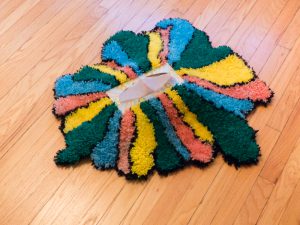
SNL: Due to our current political climate, how do you get the motivation to continue making work? Are you responding to what’s going on directly?
CA: I definitely did feel, at moments, sluggish. Like “what can we do?” The kind of work at the gallery, at the museum, interacting with a ton of different people about social justice work is really important to me. In a studio visit earlier today, we were talking about the shift in my use of materials, from liquids and ice cream that you can’t totally control, to the slowed down and very controlled process of making latch hook pieces. It requires a lot of control. I’m kind of obsessed right now with these colorful toilet papers and tissues that were all the rage in the 1970s. They aren’t manufactured anymore because they were really shitty for the environment. So these are all from eBay. I really love that they are this aestheticized version of something that you use to wipe your ass or your nose. It’s also pretty weird that they have women or little girls on them. It’s pretty fucked up but I also really like them. It’s offering some sort of comfort from this unknown source. It’s similar to these latch pieces that take a super long time to make but they have this comforting sort of feeling. Because of the forms that they are in, they have a nod to women-centered craft and the forms look uncontrolled and unrestrained even though I’m obviously planning them out. So making a move from exerting some control and trying to offer some comfort to viewers feels like where I am at.
This is a little tangential but also closely related — I’m pregnant right now.
SNL: Awwww, amazing! Congratulations!
CA: Thank you! And you know I’m a queer woman, my partner’s a woman. “How do you bring yourself to create art in this climate?” but it’s like I’m in the middle of creating a new life in this climate. It’s kind of a mind fuck. There are moments when it’s like “What are we doing?” But, more than anything, I feel a sense of defiance. It’s so important, especially for people who are in non-heteronormative relationships, to continue to have families and to continue to spread that love and create in whatever way that they can. I have been feeling that way lately. It feels difficult in moments, but I also feel a determination.
I do have some video ideas for when I’m showing. It is so pertinent to the content of my practice — these ideas of embodied experience and transformations that you aren’t entirely in control of. I mean I don’t know what’s going to come of that, but I’m really excited to get my big pregnant belly and make a video or do a live performance. It’s such a weird, fleeting identity. And you’re only that for a couple of months and then you’re a parent, which is this whole other identity. I like to think about the transitory nature of this phase.
It’s very exciting.
SNL: To wrap up, do you have any updates for the future? Shows? Exhibitions? Things like that.
CA: I’m going to be in a show at Public Access on April 14th. Their idea is a broad focus of a show about feminist representation of the body and space, and the space with body’s. Also, thinking about a desire to touch things and a refusal of being able to touch. I’m excited.
I’m also going to be in a show in the fall in Detroit at Eastern Michigan University.
Kiss the Girls: Make Them Cry
Four-person show with Claire Arctander, Becky Kolsrud, Dara Birnbaum, and Anna Showers-Cruser
Opening reception: Friday, April 14th 7-10pm
Location: Public Access
3306 W North Ave, Chicago
The Dangerous Professors
A group show
May 2017
Location: Triumph
2055 W Cermak Rd, Chicago
Intimacy and Affect
A group show
October 2017
Location: Ford Gallery, University of Eastern Michigan, Ypsilanti
Featured Image: Claire Arctander, “The Right to Piss in Different Colors, Part 2: Tributes” (still from video), 2014
 S. Nicole Lane is a visual artist, writer, and editor based in the Southside. Her work can be found on The Establishment, HelloFlo, Newcity, Bustle, and other corners of the internet, where she discusses sexual health, wellness, and the arts. Follow her on Twitter.
S. Nicole Lane is a visual artist, writer, and editor based in the Southside. Her work can be found on The Establishment, HelloFlo, Newcity, Bustle, and other corners of the internet, where she discusses sexual health, wellness, and the arts. Follow her on Twitter.
